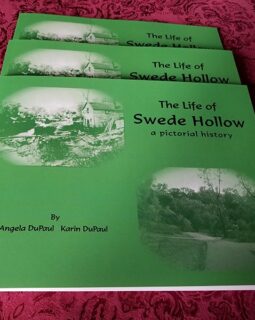The Life of Swede Hollow: a pictorial history

- Year
- 2019
- Creators
- Reviewer: Bob Muschewske
- Topics
The Life of Swede Hollow: a pictorial history
Authors: Angela DuPaul and Karin DuPaul
St. Paul, MN: Friends of Swede Hollow
115 pages; soft cover; 217 b&w photos and art; $18
In their 2019 book, The Life of Swede Hollow: a pictorial history, Angela and Karin DuPaul—a daughter and mother duo—have produced a loving tribute to a place called home by generations of immigrants arriving in St. Paul in the second half of the nineteenth century. Karin and her husband, Rich, have lived in the Dayton’s Bluff neighborhood near Swede Hollow since the mid-1970s, and Angela grew up there, so the area is dear to their hearts.
A poem by Gerry Hurd, the grandson of Mary Sanchelli, a Swede Hollow resident at the turn of the twentieth century, is included in the book and captures the essence of the place:
For many generations the immigrants came,
Perhaps seeking a fortune, or maybe fame.
They Journeyed far across the sea,
To find America, where they could be free.
Some settled in Swede Hollow on Saint Paul’s east side,
Working hard to build a new life with pride.
Swedes, Italians, Hispanics and others,
They learned to live together as sisters, and brothers . . .
A thirty-acre ravine located a half a mile east of present-day downtown St. Paul, Swede Hollow was named for the first large group of immigrants who settled there. Why there? The area was accessible to the many newcomers—mostly poor—who arrived on the train or at the dock on the nearby Mississippi River looking for an inexpensive place to live. The ravine served as a modicum of protection from the elements, and Phalen Creek and natural springs ran through the area, supplying fresh water. Finally, employment opportunities at rail yards, freight depots, factories, warehouses, mills, breweries, and bakeries were a short walk away.
As the original immigrants improved their financial situations and moved to more middle-class neighborhoods, others took their place in the Hollow. The area developed a reputation as a place where different cultures could live together in harmony as they embarked on their new lives in America.
The DuPauls organized the book into four sections:
- Life in Swede Hollow from 1860 to 1956, when it served as home to generations of immigrants;
- The businesses, churches, and schools just outside of the Hollow that played an important role in the everyday lives of its residents;
- The transformation of Swede Hollow from a de facto dump in the 1960s into the city park it is today in the Dayton’s Bluff and Railroad Island neighborhoods;
- Accounts of and reflections on Swede Hollow from former residents, descendants of those residents, and others.
The DuPauls seem to assume that readers will know exactly where Swede Hollow is located. Many will. I did not. A map at the beginning showing the location of the neighborhood in connection to the rest of St. Paul would have been helpful.
A highlight of the book is the many pictures of people and places that convey a real sense of what it was like to live in and work in or near the Hollow. The DuPauls note that not all photos came from Swede Hollow, primarily because many of the residents who lived there couldn’t afford cameras. The images come from a variety of outside sources, cameras, and photography expertise. Still, they collectively help preserve the historical record of those who called Swede Hollow home so long ago. Each image is accompanied by a brief but always informative caption.
It’s important readers understand that this is not a glossy coffee-table book nor a scholarly history. Rather, it is a delightful and personal account of a unique enclave on the city’s East Side, told by two women who have a deep affection for what Gerry Hurd describes in the closing lines of his poem:
America is greater because they came to it.
And brought their strength, courage and grit,
Theirs is a history of simple, silent glories
Kept alive by their many Swede Hollow stories.
Bob Muschewske is a retired management consultant who has worked in St. Paul since the 1970s. He is a former member of the board of Ramsey County Historical Society and is a past president of The Saint Paul Camera Club.
- Year
- 2019
- Creators
- Reviewer: Bob Muschewske
- Topics